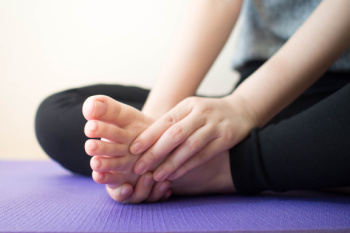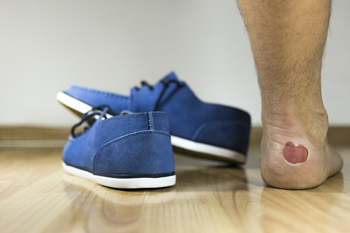Glen Allen Office
(804) 747-3380

Experiencing Achilles tendon pain while running can be quite uncomfortable, and preventing injuries is essential. The Achilles tendon connects the major calf muscles, the gastrocnemius and soleus, to the back of the heel bone. When it is subjected to excessive stress, it tightens and is forced to work too hard. This can lead to irritation or inflammation, which is commonly referred to as Achilles tendinitis. Over time, scar tissue, which is less flexible than the tendon, can develop on it. If the inflamed Achilles tendon continues to endure stress, it may tear or rupture, resulting in an Achilles heel injury. To address Achilles pain during running, the first step is to stop running when you feel discomfort. It is important to rest and seek professional advice from a podiatrist to assess the condition of your lower leg. Continuing to run with Achilles pain can potentially worsen the injury. If you are experiencing Achilles pain from running, it is suggested that you schedule an appointment with a podiatrist for a proper diagnosis and treatment plan.
Achilles tendon injuries need immediate attention to avoid future complications. If you have any concerns, contact one of our podiatrists of The Podiatry Center. Our doctors can provide the care you need to keep you pain-free and on your feet.
What Is the Achilles Tendon?
The Achilles tendon is a tendon that connects the lower leg muscles and calf to the heel of the foot. It is the strongest tendon in the human body and is essential for making movement possible. Because this tendon is such an integral part of the body, any injuries to it can create immense difficulties and should immediately be presented to a doctor.
What Are the Symptoms of an Achilles Tendon Injury?
There are various types of injuries that can affect the Achilles tendon. The two most common injuries are Achilles tendinitis and ruptures of the tendon.
Achilles Tendinitis Symptoms
Rupture Symptoms
Treatment and Prevention
Achilles tendon injuries are diagnosed by a thorough physical evaluation, which can include an MRI. Treatment involves rest, physical therapy, and in some cases, surgery. However, various preventative measures can be taken to avoid these injuries, such as:
If you have any questions please feel free to contact one of our offices located in Richmond and Glen Allen, VA . We offer the newest diagnostic tools and technology to treat your foot and ankle needs.

Selecting proper footwear is essential for managing arthritis-related foot pain and maintaining mobility. Shoes should support individual foot types and joint conditions to prevent discomfort and enhance movement. Features such as stabilizing cushioning, roomy toe boxes, and rocker bottoms may help to alleviate pressure on the forefoot. Casual shoes and athletic sneakers with supportive cushioning are recommended, while dress shoes should prioritize function over style, favoring a wide-toe box and sturdy heels. Sandals with adjustable straps provide customized fit and support, while flip-flops may increase instability. Ultimately, choosing appropriate footwear can significantly improve comfort and mobility for individuals with arthritis. If you suffer from arthritis and it causes foot discomfort, it is suggested that you schedule an appointment with a podiatrist to discuss specific shoe recommendations that may improve your comfort and quality of life.
Arthritis can be a difficult condition to live with. If you are seeking treatment, contact one of our podiatrists from The Podiatry Center. Our doctors can provide the care you need to keep you pain-free and on your feet.
Arthritic Foot Care
Arthritis is a term that is commonly used to describe joint pain. The condition itself can occur to anyone of any age, race, or gender, and there are over 100 types of it. Nevertheless, arthritis is more commonly found in women compared to men, and it is also more prevalent in those who are overweight. The causes of arthritis vary depending on which type of arthritis you have. Osteoarthritis for example, is often caused by injury, while rheumatoid arthritis is caused by a misdirected immune system.
Symptoms
Arthritic symptoms range in severity, and they may come and go. Some symptoms stay the same for several years but could potentially get worse with time. Severe cases of arthritis can prevent its sufferers from performing daily activities and make walking difficult.
Risk Factors
If you suspect your arthritis is affecting your feet, it is crucial that you see a podiatrist immediately. Your doctor will be able to address your specific case and help you decide which treatment method is best for you.
If you have any questions, please feel free to contact one of our offices located in Richmond and Glen Allen, VA . We offer the newest diagnostic and treatment technologies for all your foot care needs.

Foot blisters, those fluid-filled sacs that form on the skin, often arise from a combination of factors, shedding light on the intricate nature of their formation. In scenarios of low friction, prolonged moisture exposure, and ill-fitting footwear, the outer layer of the skin becomes susceptible to damage. Excessive moisture softens the skin, making it more prone to friction and subsequent blistering. Additionally, wearing tight or poorly cushioned shoes can create constant rubbing against the skin, aggravating the vulnerability. Soft tissue distortions, such as bunions or hammertoes, contribute to increased pressure on specific areas of the foot, intensifying the likelihood of blister formation. Understanding the interplay of these factors underscores the importance of proper footwear, moisture management, and addressing foot deformities to prevent blistering. By acknowledging the various causes of foot blisters, patients can take proactive measures to safeguard their feet and maintain optimal skin health. If you have developed blisters on your feet that have become infected, it is suggested that you confer with a podiatrist who can treat this condition, and offer effective blister prevention techniques.
Blisters may appear as a single bubble or in a cluster. They can cause a lot of pain and may be filled with pus, blood, or watery serum. If your feet are hurting, contact one of our podiatrists of The Podiatry Center. Our doctors can provide the care you need to keep you pain-free and on your feet.
Foot Blisters
Foot blisters are often the result of friction. This happens due to the constant rubbing from shoes, which can lead to pain.
What Are Foot Blisters?
A foot blister is a small fluid-filled pocket that forms on the upper-most layer of the skin. Blisters are filled with clear fluid and can lead to blood drainage or pus if the area becomes infected.
Symptoms
(Blister symptoms may vary depending on what is causing them)
Prevention & Treatment
In order to prevent blisters, you should be sure to wear comfortable shoes with socks that cushion your feet and absorb sweat. Breaking a blister open may increase your chances of developing an infection. However, if your blister breaks, you should wash the area with soap and water immediately and then apply a bandage to the affected area. If your blisters cause severe pain it is important that you call your podiatrist right away.
If you have any questions, please feel free to contact one of our offices located in Richmond and Glen Allen, VA . We offer the newest diagnostic and treatment technologies for all your foot care needs.

Ankle sprains come in various forms, each accompanied by distinct symptoms that highlight the complexity of this injury. The lateral ankle sprain is the most common, occurring when the foot turns inward,which stretches or tears the ligaments on the outer side of the ankle. Individuals experiencing a lateral sprain may encounter pain, swelling, and difficulty bearing weight on the affected foot. Medial ankle sprains, less frequent but equally impactful, involve damage to the ligaments on the inner side of the ankle, often leading to tenderness and swelling. High ankle sprains affect the ligaments that connect the tibia and fibula, causing pain above the ankle and potentially affecting stability. Regardless of the type of sprain, common symptoms include bruising, limited range of motion, and a feeling of instability. If you have endured an ankle sprain, it is suggested that you visit a podiatrist who can determine which type it is and offer appropriate treatment solutions.
Ankle sprains are common but need immediate attention. If you need your feet checked, contact one of our podiatrists from The Podiatry Center. Our doctors can provide the care you need to keep you pain-free and on your feet.
How Does an Ankle Sprain Occur?
Ankle sprains take place when the ligaments in your ankle are torn or stretched beyond their limits. There are multiple ways that the ankle can become injured, including twisting or rolling over onto your ankle, putting undue stress on it, or causing trauma to the ankle itself.
What Are the Symptoms?
Preventing a Sprain
Treatment of a Sprain
Treatment of a sprain depends on the severity. Many times, people are told to rest and remain off their feet completely, while others are given an air cast. If the sprain is very severe, surgery may be required.
If you have suffered an ankle sprain previously, you may want to consider additional support such as a brace and regular exercises to strengthen the ankle.
If you have any questions please feel free to contact one of our offices located in Richmond and Glen Allen, VA . We offer the newest diagnostic and treatment technologies for all your foot and ankle needs.